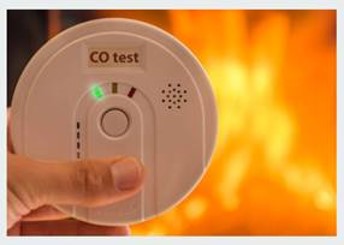Ontario’s annual Carbon Monoxide Awareness Week is taking place from November 1 to 7. Carbon Monoxide (also known as CO) is a silent killer because it has no taste, smell or colour. To help prevent carbon monoxide poisoning, Central York Fire Services (CYFS) reminds residents that it is essential to have a working carbon monoxide alarm in your home.
In Ontario, approximately 65% of all carbon monoxide deaths and injuries occur in homes,” says Fire Chief Ian Laing. “A functioning carbon monoxide alarm will alert people when carbon monoxide levels are dangerous and allow them to safely and quickly leave their home.”
Fuels like natural gas, propane, wood, oil, and kerosene produce carbon monoxide when there is insufficient air for them to burn completely. The risk of carbon monoxide increases in the winter when homes are heated with these appliances. In Ontario, it is a legal requirement to have working carbon monoxide alarms outside sleeping areas to ensure they are heard if they are activated.
For more ways to protect you and your family against carbon monoxide, please follow the carbon monoxide safety tips below:
- To avoid a carbon monoxide hazard, always check that the air supply to your fuel- burning appliances is sufficient.
- Carbon monoxide alarms should be installed close to sleeping areas. You need more than one carbon monoxide alarm if your house or cottage has bedrooms on more than one floor.
- Ensure that every fuel-burning system, appliance, and chimney is properly vented and is maintained once a year by a licensed service technician or heating contractor.
- Make sure that ice or snow is not blocking the vent of your appliance.
- Even if the garage door is open, never operate a vehicle or other motor indoors.
- Never use portable fuel-burning camping gear inside a building, garage, car, or tent
unless it is made specifically for use there.
- Once a year, chimneys and flues should be cleaned and inspected to make sure there is adequate ventilation because animals and bird nests, snow, ice, and other debris can prevent gases from escaping your chimney.
- In addition to flu-like symptoms like headaches, nausea, and dizziness, carbon monoxide exposure can also result in confusion, drowsiness, loss of consciousness, and even death. Get everyone out of the house right away and move to fresh air if anyone in the home is showing signs of carbon monoxide poisoning, or if your carbon monoxide alarm sounds. From outside the house, dial 9-1-1.
- Every month, make sure your smoke and carbon monoxide alarms are in good working order. Ensure that everyone in your home is aware of the distinction between the two noises.
CYFS continues to support the Hawkins-Gignac Foundation which helps educate the public about Carbon Monoxide. Together with the community, $1,232 was raised at the Open House and donated to the foundation.
For more information, visit www.cyfs.ca.








